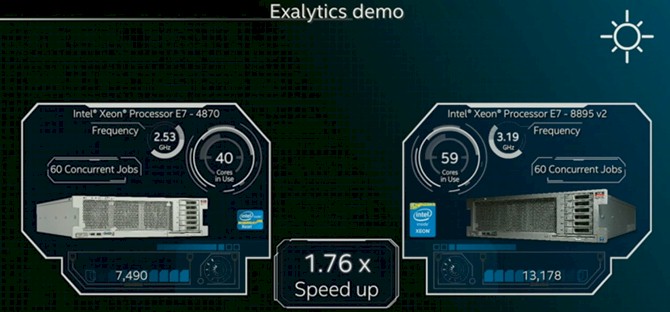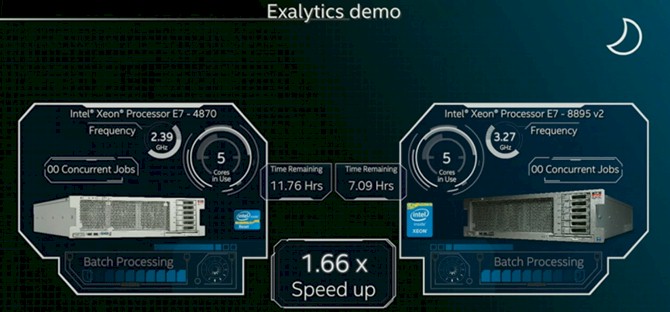Oracle Doubles Exalytics In-Memory Performance, Holds Price Steady

Back in July, Oracle updated its Exadata database cluster appliances with a custom Intel processor, and this week at its OpenWorld 2014 extravaganza in San Francisco, the software giant and system vendor is taking the wraps off a new Exalytics in-memory appliance that is based on the same custom Intel chip.
Both the Exadata X4-8 nodes and the Exalytics X4-4 appliance are based on the Xeon E7-8895 v2 processor, which is in the "Ivy Bridge" family and which is a modified version of the 15-core top-bin chip that has 37.5 MB of L3 cache and that has a base frequency of 2.8 GHz. Depending on how many cores are active and how active they are, the clock frequency on a core in this custom E7-8895 v2 chip can be boosted to anywhere between 3.4 GHz and 3.6 GHz, and importantly, there are hooks exposed in this chip that allow for Oracle's operating system, database, and application software to reach in and set power states on the processor as the workload demands. It is a more active power and performance control, in a sense, than is available with the regular Xeon E7 chips.
The Exalytics X4-4 is a four-socket machine and comes with a full complement of 60 cores, but only has 2 TB of main memory compared to the maximum of 3 TB of memory that a four-socket box using the Xeon E7 v2 processors can support. Oracle is no doubt leaving a little expansion room for customers who might need even larger data sets, and frankly, buying a four-socket machine with 2 TB of main memory is pretty hefty as a base configuration, and using 32 GB memory sticks as this machine does is also not exactly normal yet in the server market. Moreover, with various data compression algorithms, Oracle can boost the effective capacity of that main memory by a factor of ten or so, and there are not very many databases that are larger than a this memory capacity in the enterprise. Hyperscale datacenter operators for sure have much larger datasets, and some enterprises do as well.
The Exalytics X4-4 system uses three of Oracle's F80 PCI-Express eMLC flash cards with a total capacity of 2.4 TB and six 10K RPM SAS-2 disk drives with 7.2 TB of disk to host operating system and application code and to backup data stored in memory. The machine runs Oracle Linux, the company's variant of Red Hat Enterprise Linux, and can be carved up into four virtual machines using Oracle VM, the company's implementation of the Xen hypervisor, to partition up workloads. The system has two 40 Gb/sec InfiniBand ports to link to Oracle's Exadata database appliances, so data can be quickly extracted from production databases and sucked into a number of different in-memory databases for analysis. It also has two 16 Gb/sec Fibre Channel links for hooking into external disk storage arrays and four 10 Gb/sec Ethernet ports for hooking to end users who are querying the system.
The prior generation Exalytics X3-4 system was based on the "Westmere" Xeon E7 v1 processors and topped out at 40 cores with 2 TB of main memory, 2.4 TB of flash, and 5.4 TB of disk. This machine was announced in July 2013 and has seen decent adoption according to Oracle.
In his keynote this week at OpenWorld, Oracle co-founder, chairman, and CTO Larry Ellison said that the combination of 50 percent more cores, a 50 percent higher clock speed (thanks to the customized TurboBoost tweaks), and 50 percent more main memory (when loaded up with 3 TB), was allowing customers who were doing in-memory analytics to see a performance increase of anywhere from 10X to 100X compared to doing queries on disk-based database servers enhanced with flash like the Exadata platforms. With the Oracle Essbase OLAP server, the speedup is around a factor of two moving from the Exalytics X3-4 to the X4-4 machine; Ellison did not provide performance specs for the TimesTen in-memory database that is also available on the machine. For the first time, Oracle is also allowing customers to load up the standard Oracle 12c on the Exalytics appliances and use the in-memory features of that database to do high speed queries. Again, performance specs were not given for how the Exalytics machine might do compared to other Oracle iron running the same Oracle 12c database. But the important thing is that by supporting Oracle 12c on the Exalytics, customers can have the same database in their analytics environment that they have in their production environment.
As part of her keynote, Renee James, president at Intel, did some demos showing the contrast in performance of the two most recent Exalytics generations on two different benchmark tests using the Essbase multidimensional database. The problem that Oracle is trying solve with the tweaked Exalytics box is one that online systems have been facing for five decades: the company wants to run production query workloads during the day and batch workloads at night when everyone has gone home, and do it all on the same system. During the day, the goal is to have as many managers and analysts hammering away at queries as they can against the data. Here is a comparison of the two generations of Exalytics machines running Essbase queries and the number of users supported on each:
As you can see, both machines are supporting 60 concurrent jobs. The X3-4 box on the left has 40 cores running at 2.53 GHz and is supporting 7,490 transactions per second, while the X4-4 box on the right has 59 of its total 60 cores activated and they are cranked up to 3.19 GHz. The important thing is that the machine on the left could support 13,178 transactions per second, or do 1.76 times as much work, thanks to the clock scaling features that Intel and Oracle have worked out. This test was with approximately 200 users on the new machine, Oracle said in the demo, but this added performance could mean that existing end users can ask nearly twice as many questions and still not bog down the Exalytics machine.
When night rolls around, users have gone home but there are larger batch analytics jobs, with much deeper correlations, than need to be run, and there is a window of time within which this work has to be finished. The dreaded batch window. Such batch processing work is generally not particularly parallel, and so in this case, having more clock speed on fewer cores helps the work finish faster. On a particular Essbase batch job, the new machine delivered a factor of 1.66 speedup:
As the test ran, the core speed on the five active cores in the X4-4 settled down and was able to push up to 3.4 GHz, although the screen shot above shows 3.27 GHz. The important thing here is that batch window. On the old X3-3 machine, five cores running at 2.39 GHz took nearly twelve hours to run, which is too long to fit into the business day cycle. But with the faster X4-4 machine, the same batch operations in Essbase took a little over 7 hours to complete, which gives room for work to start a little late in the day and still get done before people come back to work the next day. The faster batch times also mean customers can run more scenarios and simulations against their financial data.
The Exalytics X4-4 is available now and has the same $175,000 price tag as its X3-4 predecessor. This is in keeping with Oracle's past practice of letting Moore's Law boost performance while keeping prices more or less the same. Premier support for the systems costs $21,000 per year. You can rent capacity on a hosted Exalytics X4-4 on the Oracle cloud for $10,000 per month. The TimesTen in-memory database for the Exalytics box costs $34,500 plus $7,590 per year for support, or you can buy a per-user license at $300 a pop plus $66 for support. A separate set of software called the Exalytics In-Memory Software offers special optimizations for TimesTen and Essbase and hooks to Oracle Business Intelligence Presentation Server; it costs $30,000 plus a $6,600 in annual support fees.












